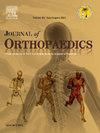Does perioperative hypothermia after primary total hip and knee arthroplasty affect acute outcomes?
IF 1.5
Q3 ORTHOPEDICS
引用次数: 0
Abstract
Background
Intraoperative hypothermia (HT) is commonly experienced among patients undergoing total joint arthroplasty (TJA) and may be associated with increased blood loss, pain, and complications. Our study evaluated acute outcomes of patients with and without HT after primary total hip (THA) and knee arthroplasty (TKA).
Methods
We identified 220 postoperative HT TJA cases (119 THAs and 101 TKAs) at a single institution as defined by a body temperature of <96.8° Fahrenheit (F) immediately in the post-anesthesia care unit (PACU). Cases were matched to non-hypothermia (NHT) controls 1:2 based on procedure type, age, sex, and body mass index. Intraoperative, immediate PACU, and 90-day outcomes were compared, including vital signs, blood loss, pain scores, opioid use, length of stay (LOS), complications, reoperations, Hip Osteoarthritis Outcome Score, Jr (HOOS), and Knee Osteoarthritis Outcome Score, Jr (KOOS).
Results
HT patients after THA and TKA did not experience significant differences in immediate PACU or hospital-based outcomes, including vital signs, pain scores, opioid consumption, LOS, or home discharge (P ≥ 0.1). Additionally, there were no differences in readmissions, VTEs, or HOOS/KOOS at 90 days (P ≥ 0.2). Although not statistically significant, HT THA patients trended toward more reoperations compared to NHT (5 versus 1.7 %, respectively, P = 0.08), but not for TKA (P = 0.5). Wound debridement for debridement for superficial wound dehiscence was the most common reoperation in HT cohorts.
Conclusion
TJA patients experiencing perioperative HT do not have clinically significant different acute recovery and 90-day outcomes compared to NHT controls. While surgical patient normothermia remains important, both anesthetic and surgical considerations should be factored into determining the most optimal operating room temperature.
求助全文
约1分钟内获得全文
求助全文
来源期刊

Journal of orthopaedics
ORTHOPEDICS-
CiteScore
3.50
自引率
6.70%
发文量
202
审稿时长
56 days
期刊介绍:
Journal of Orthopaedics aims to be a leading journal in orthopaedics and contribute towards the improvement of quality of orthopedic health care. The journal publishes original research work and review articles related to different aspects of orthopaedics including Arthroplasty, Arthroscopy, Sports Medicine, Trauma, Spine and Spinal deformities, Pediatric orthopaedics, limb reconstruction procedures, hand surgery, and orthopaedic oncology. It also publishes articles on continuing education, health-related information, case reports and letters to the editor. It is requested to note that the journal has an international readership and all submissions should be aimed at specifying something about the setting in which the work was conducted. Authors must also provide any specific reasons for the research and also provide an elaborate description of the results.
 求助内容:
求助内容: 应助结果提醒方式:
应助结果提醒方式:


